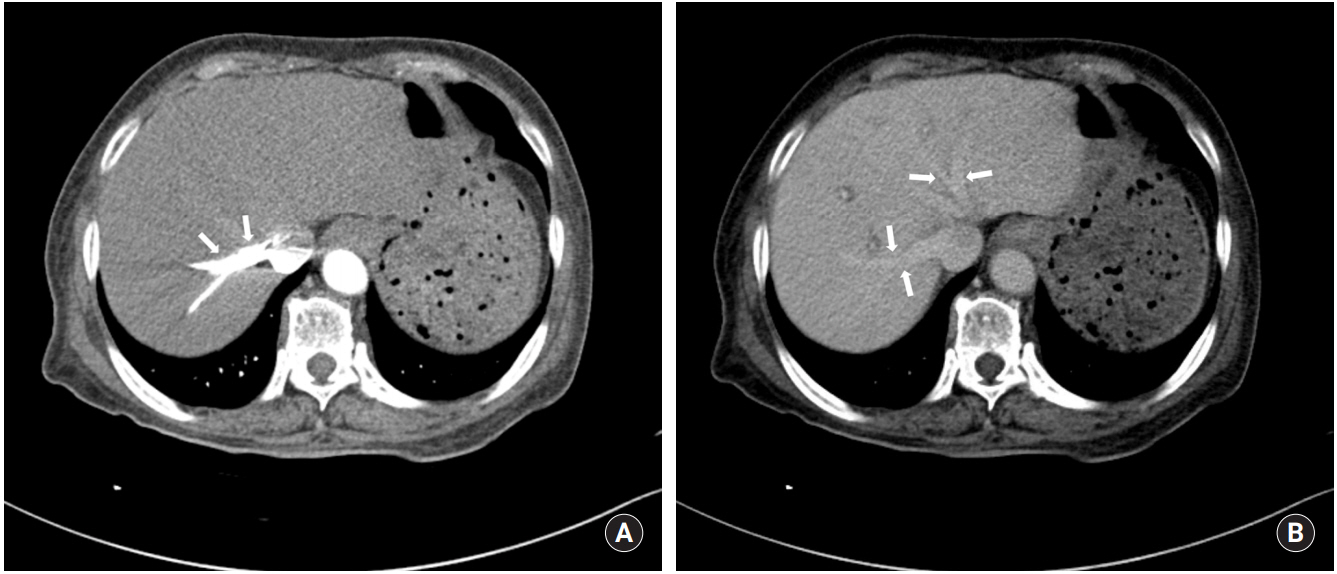Introduction
Acupuncture is used to relieve or treat a certain disease by inserting one or more needles in a specific site of the body [1]. Acupuncture has been widely practiced in the East as a therapeutic intervention, and acknowledgment of its utility and safety lead to gradual spread to the West [2].
Acupuncture is regarded as relatively safe, as the risk of a serious adverse event after acupuncture is estimated to be only 0.05 per 10,000 treatments, and 0.55 per 10,000 individual patients. However, severe and fatal adverse events are being constantly reported [3]. We report a case of cardiac tamponade after acupuncture with decreased consciousness and dyspnea, with a review of related literature.
Case report
A 73-year-old female patient with no known previous illness developed decreased consciousness and dyspnea after visiting an oriental clinic had acupuncture applied at epigastric and scapular area to treat intermittent epigastric pain and dyspepsia which started a month earlier. She was transferred to our hospitalŌĆÖs emergency department(ED). At the time arrived at the ED, mental status was drowsy, and the initial vital signs were a blood pressure of 60/40 mmHg, a pulse rate of 110 beats/min, a respiratory rate of 23 breaths/min, and a body temperature of 35.0┬░C. On physical examination, jugular venous distension was observed, with a distant heart sound on auscultation, and the abdomen was flat without tenderness. Laboratory findings were as follows: white blood cell count, 6,570/mm3(neutrophils 30%); hemoglobin, 13.2g/dL; hematocrit, 39.9%; plateletcount, 167,000/mm3; aspartatetransaminase, 76 IU/L; alaninetransaminase, 24 IU/L; CK-MB, 1.0ng/mL; and troponin-I, 0.072ng/mL. Electrocardiography revealed arterial fibrillation without change of the ST segment. The chest X-ray showed enlarged, globular-shaped heart (Fig. 1); the echocardiography, pericardial effusion; and chest computed tomography(CT) scan, a small amount of pneumothorax in left hemithorax along with a large volume of pericardial effusion (Fig. 2,3). Any specific finding was not shown except hepatic congestion in abdominal CT (Fig. 4).
Based on the aforementioned test findings and the patientŌĆÖs symptoms immediately after acupuncture, she was diagnosed as cardiac tamponade caused by acupuncture. A pericardial window operation was done, concerning the risk of heart injury with pericardiocentesis via bedside transthoracic echocardiography. 300cc of bloody pericardial effusion was drained through pericardial window creation, and membranous tissues of the blood clot were found. The patient fully recovered after surgery and was discharged without complications.
Discussion
Acupuncture is performed not only to control pain but also for a variety of reasons, such as obesity control, cessation of smoking, relief of tinnitus, post-stroke rehabilitation, treatment of rheumatic diseases, etc [4]. It is generally regarded as a safe procedure, if performed by a well-trained and experienced practitioner, but it can lead to various complications in practice [5]. Most of adverse events of acupuncture are mild, such as bleeding, hematoma, local infection, headache, and myalgia, but there can be serious adverse events such as neural damage, pneumothorax, hepatitis, perforation of internal organs, spinal cord damage, and cardiac tamponade [6].
Generally, 2cm- to 5cm-long, 26- to 32-gauge needles are used in acupuncture, which can damage the nervous system and blood vessels if they penetrate the thoracic and abdominal viscera [7,8]. Therefore, cardiac tamponade can occur, though rarely, when acupuncture is performed in the thoracic cage, and this may be fatal [9]. According to the review of literature of Ernst and Zhang [9], 26 patients were diagnosed with cardiac tamponade after acupuncture in 17 studies reported up to 2010, in which eleven of the patients fully recovered after surgery or other treatment, and 14 died.
Cardiac tamponade generally occurs after the heart is compressed through the accumulation of fluid, pus, blood, clots, or gas in the pericardium [10]. Common causes include hemorrhage from chest trauma, metastatic malignancy, pericarditis, uremia, etc [11]. The mechanism of cardiac tamponade caused by acupuncture includes cardiac tissue or vessel injury by the needle, and damage of the right ventricular wall due to the inflow of the needle through the bloodstream [12,13]. Direct cardiac damage is also associated with penetration of the sternum through congenital sternal foramen, a malformation found in 5ŌĆō8% of the population [14]. It is usually hidden by tendon fibers, connective tissue, bone, so it cannot be easily detected through palpation. Lee et al. [15] reported a case of a patient who presented chest pain after acupuncture in his upper abdomen. The patient was diagnosed with cardiac tamponade caused by a broken acupuncture needle that moved to the right ventricle and was detected in the fluoroscopy, computed tomography, and trans-esophageal echocardiography, and the needle was successfully removed through cardiac surgery. A recent case of cardiac injury due to acupuncture was in four cases (Table 1).
In this case, a patient without any previous illness was transferred to the ED in shock state, just after undergoing acupuncture in her scapula and upper abdomen. Echocardiography confirmed pericardial effusion and pneumothorax was presented on chest CT scan, but no foreign body was detected. A pericardial window operation was performed, acupuncture needles were not found and the biopsy results after the surgery showed no specific finding other than blood clots, which ruled out secondary causes such as metastatic malignancy. The patient was diagnosed with acute cardiac tamponade due to direct cardiac injury by acupuncture needle. In chest CT scan, pneumothorax occurs in the anterior part of the left lung, so it is estimated that the pericardiac tamponade is caused by upper abdomen acupuncture rather than the scapula.
Complications related to acupuncture result from the lack of anatomical knowledge and hygiene of the practitioners [20]. Practitioner education on the human anatomy and hygiene should be strengthened, and patient education on acupuncture complications and precautions are needed to prevent severe complications. Also, practitioners should be aware of the possible adverse events following acupuncture and should be able to treat emergency cases. Emergency physicians should be aware of the occurrence of cardiac tamponade after acupuncture through a detailed medical examination to improve the patient prognosis through early diagnosis and treatment.












